Proctoporus is a genus of medium-sized lizards assigned to the family Gymnophthalmidae. Species in the genus Proctoporus occur in Yungas forests and wet montane grasslands on the upper edge of the Amazonian forest, between 1,000 and 4,000 metres elevation, from Central Peru in the north to Central Bolivia in the south.

Telmatobius is a genus of frogs native to the Andean highlands in South America, where they are found in Ecuador, Peru, Bolivia, northwestern Argentina and northern Chile. It is the only genus in the family Telmatobiidae. Some sources recognize Batrachophrynus as a valid genus distinct from Telmatobius.
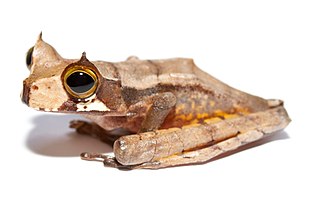
Gastrotheca is a genus of frogs in the family Hemiphractidae. They are found in Central America south of Costa Rica and in South America. Most species occur in the American Cordillera from southern Costa Rica to north-western Argentina. This genus makes up the bulk of marsupial frog diversity; formerly it was placed in the "Leptodactylidae" assemblage.

Phrynopus is a genus of frogs of the family Strabomantidae. Their common name is Andes frogs. They are endemic to Peru and inhabit the upper humid montane forest and supra-treeline grassland in the Cordillera Oriental, with one record from the Peruvian Cordillera Occidental.

Centrolene is a genus of glass frogs in the family Centrolenidae. The adult males are characterized by having a humeral spine, as most members of this family. The delimitation of this genus versus Cochranella is not fully resolved, and some species formerly in Centrolenella — which is nowadays synonymized with Centrolene — are now in Hyalinobatrachium.

Oreobates is a genus of frogs in the family Strabomantidae. Most species were formerly in the genus Ischnocnema, but were moved to this revalidated genus following a 2006 revision. Its sister taxon is Lynchius.
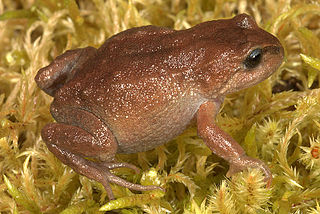
Bryophryne cophites, also known as the Cusco Andes frog or the Cuzco Andes frog, is a species of frog in the family Strabomantidae. It is endemic to Peru and known only from slopes of the Abra Acanacu in the Cordillera de Paucartambo, Cusco Region. There is an unconfirmed record from a neighboring mountain range, so this species might be more widespread than current knowledge suggests.
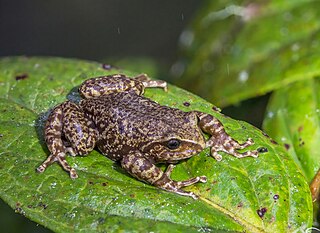
Pristimantis is a very large genus of frogs distributed in the southern Caribbean islands and in Central and South America from Honduras to northern Argentina and southern Brazil. With 596 described species, the genus had more species than any other genus of vertebrate animals. Many of these species genus are endemic to the Northwestern Andean montane forests ecoregion in north-western South America.
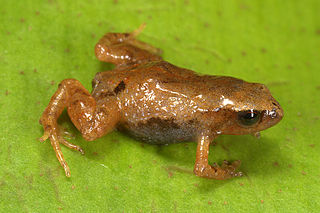
The Strabomantidae are a family of frogs native to South America. These frogs lack a free-living larval stage and hatch directly into miniature "froglets". This family includes Pristimantis, the most speciose genus of any vertebrate.

Bryophryne is a genus of frogs in the family Strabomantidae. These frogs are endemic to south-eastern Peru in the Cusco Region, with an undescribed species from the Puno Region. Their range is separated from that of Phrynopus by the Apurímac River valley.

Telmatobius ventriflavum, the Andean Water Frog, is a species of water frogs from the western Andes in Peru.

Psychrophrynella is a genus of frogs in the family Strabomantidae The genus is distributed on the Andes of southern Peru and Bolivia. One of the four species assessed by the International Union for Conservation of Nature (IUCN) is assessed as "Critically Endangered".

Noblella is a genus of frogs in the family Strabomantidae. They are found on the eastern slopes of the Andes and in the Amazon Basin in Colombia, Ecuador, Peru, Bolivia, and western Brazil. The name refers to Gladwyn K. Noble, who described the first species.
Petracola is a genus of lizards in the family Gymnophthalmidae. The genus is endemic to Peru.
Selvasaura is a genus of the lizard family Gymnophthalmidae. The genus contains three species.
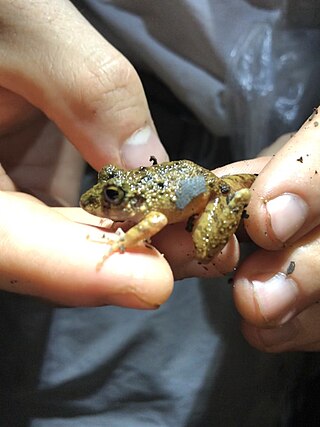
Oreobates amarakaeri, also known as Amarakaeri's big-headed frog is a species of frog in the family Strabomantidae, which is endemic to a small region of south-eastern Peru, in the Manú District, and parts of the Puno Region. The frog was first discovered near the Rio Nusinuscato and Rio Mabe rivers in the Andean foothills of the Amarakaeri Communal Reserve, which are tributaries of the Rio Araza. Since then the species has also been found at the Manú Learning Centre and near Bahuaja Sonene National Park, but weren't fully confirmed to be there until 2019 when four specimens were collected at those localities. At the Manú Learning Centre the frog is known to occur mainly in low disturbance and primary forest habitat, but can also be found near streams in more disturbed areas.
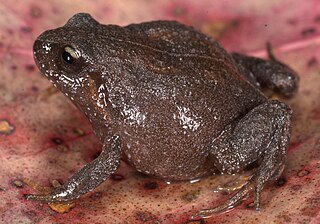
Qosqophryne gymnotis is a species of frog in the family Strabomantidae. It is known from only two sites near Abra Malaga, Cusco, Peru, at between 3,272 and 3,530 meters above sea level. Its natural habitat is high altitude montane cloud forests, and lays its eggs in wet mosses. It was originally classified as a member of Bryophryne, but was later moved to the newly created genus Qosqophryne.
Qosqophryne flammiventris is a species of frog in the family Strabomantidae. It is only found in Vilcabamba, Cusco, Peru, at 3,000 meters above sea level. Its natural habitat is high altitude montane grasslands, where it lives in thick layers of moss. It was originally classified as a member of Bryophryne, but was later moved to the newly created genus Qosqophryne.
Qosqophryne mancoinca is a species of frog in the family Strabomantidae. It is only found in Santa Teresa, Cusco, Peru, between 3,519 and 3,707 meters above sea level. Its natural habitat is high altitude montane grasslands and cloud forests. It was originally classified as a member of Bryophryne, but was later moved to the newly created genus Qosqophryne.
Lily O. Rodríguez is a Peruvian zoologist (herpetologist), ecologist and an expert in biodiversity conservation with extensive experience in international cooperation. In 2017, she was the Chair of Resources and Environmental Economics at the University of Bonn, Germany.












